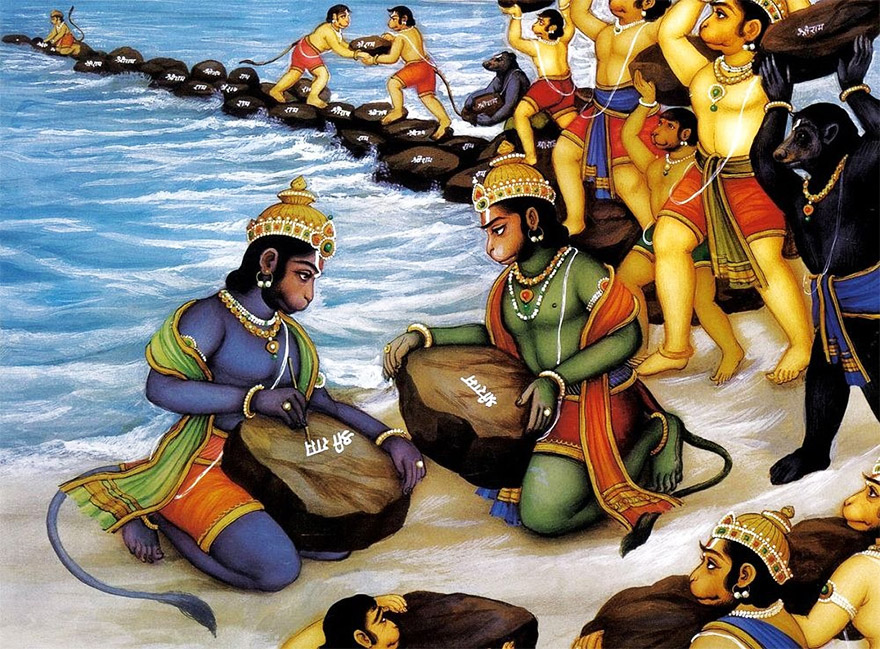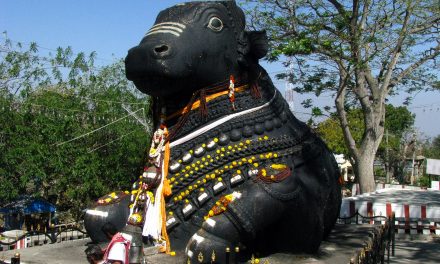India’s Ramayana refers to an island called Lanka somewhere in the southern ocean beneath the Indian subcontinent. Scholars initially sought to forge a link between the island of the Ramayana with the former British crown colony of Ceylon, which is known today as Sri Lanka.
Despite this interpretation, however, there is a valid reason behind the consideration of an alternate location for Lanka that is based on the contents of certain Vedic astronomy texts. During ancient times, all Indian astronomical observations were made with reference to a prime meridian–a line of longitude extending from one pole of the Earth to the other and also passing directly through the center of the Indian subcontinent. India’s prime meridian was the precursor to the prime meridian (0 degrees longitude) of modern times, which by international agreement is conceived to pass through the Greenwich observatory in England.
This prime meridian passes directly through the city of Ujjain, which is one reason why many historians believe that this central Indian city was the birthplace of Vedic astronomy. The astronomical texts also state that the termination point India’s prime meridian was an island called Lanka located at the Earth’s equator. With reference to our modern system of designating meridians of latitude and longitude, the ancient city of Ujjain is located at 76 degrees East Longitude and 24 degrees North Latitude. The island known today as Sri Lanka is located at approximately 81 degrees East Longitude and 7 degrees North Latitude. Even if we allow for a degree of measurement inaccuracy on the part of the early Indian geographers, the difference in longitude between the astronomical site for Lanka and the island of Sri Lanka is considerable.
Ujjain’s latitude of nearly 24 degrees North was important to early Indian astronomers such as Varahamahira, who observed that in the Kingdom of Avanti, the sun formerly passed directly overhead around the time of the summer solstice. The Indian astronomer probably used a vertical stick called a gnomon to measure shadows cast by the sun. This instrument would have allowed him to see that the gnomon would cast no shadow whatsoever as it passed directly overhead at the time of the June solstice. Since he and other Vedic astronomers held that the island of Lanka was located at the earth’s equator, the sun would have to have been directly overhead in Lanka at the time of the two equinoxes each year.
The modern globe and atlas show no island in the vicinity of the Earth’s equator that would suggest an actual geographic location for Lanka in the vicinity of India’s ancient prime meridian. Our difficulty in locating Lanka, however, can be plausibly resolved by assigning Lanka a celestial location rather than a geographical location on the surface of the Earth itself. This is an idea which compels one to evaluate the role of the hero of the Ramayana story in a whole new light.
The fact that the hero Rama bears solar attributes is indisputable, for the story as it is portrayed at Prambanan begins by proclaiming him to be an incarnation of the solar deity Vishnu. Rama’s descent to the island of Lanka to battle the Lord of Lanka at the earth’s equator, as well as his return to the city of Ayodhya in the north, has its celestial parallel in the form of the sun’s annual journey between the equinoxes and the solstices.
According to the Dutch scholar Wilhelm Stutterheim, the placement of the Ramayana reliefs at Prambanan suggest that they were intentionally organized to coincide with the position of the Sun’s movements at various times of the day as well as during the course of its annual solar cycle.
“Taking the nature of these points into consideration, it does not seem to me too wild a supposition that the transition and turning-points in Rama’s career as depicted on the Siva temple are associated with the corresponding points in the course of the sun. It is surely no accident that Rama’s rise, decline and second rise coincide with the rise, decline, and rise of the sun in its daily course, if we speak of the eastern, southern, western, and northern points in that order, or in its annual course, taking the labels spring, summer, autumn and winter points to be appropriate….
“As we know, each quarter of the series as a whole is divided into six panels, making twenty-four panels in all. Provisionally assuming that it is the annual course of the sun that is symbolized here, the conclusion seems warranted, to my mind, that each panel represents a 1/24th part of that course. This then is half a month, or, more accurately, a paksa….” [7]
At Prambanan, the eastern entranceways to the Brahma, Shiva and Vishnu temples may have been meant to coincide with Java’s spring equinox, which occurs during the month of September at all locations south of the Earth’s equator. The final panel of the Rama series, which is located just to the northeast of the entranceway, portrays Hanuman’s monkey army crossing the bridge they have built to connect the mainland to the island of Lanka. This panel also serves as the “bridge” between the opening Rama reliefs on the Shiva temple and the remaining reliefs that are displayed on the low balustrade of the Brahma temple to the immediate south.
The organization neatly ties Lanka’s location at the Earth’s equator at the time of the vernal equinox, when the sun at the time of its zenith passes directly overhead all locations on the equator. A possible solar organization can also be discerned in the Lalitavistara reliefs at Borobudur, where the panel that portrays the Bodhisattva announcing his impending descent appears next to the gallery’s eastern entrance, his birth in close proximity to the south gate, the end of his life as a householder next to the western gallery entrance and his arrival at the Bodhi tree in the north. [8]
As modern geography demonstrates, the Lanka of India’s early astronomers is perhaps a celestial location rather than an actual physical place. In this way it might be regarded similarly as the cosmic mountain Meru of Indian cosmography. Some find that it is not unreasonable to presume that the island’s location could be rightfully claimed by any islanders living in the vicinity of the Earth’s equatorial region.
Furthermore, an inscription discovered at the hilltop site of Ratu Boko overlooking Prambanan not only appears to suggest the presence of Mahayana Buddhist monks from Sri Lanka on the island toward the end of the eighth century CE, but also tells us that the monastery the inscription commemorates was named after one of Sri Lanka’s famous Buddhist religious foundations: the Abhayagiri. [9]
Regardless of one’s conclusions as to the placement of Sri Lanka, it is clear that Javanese poets were engaged in the intentional transposition of “…what are basically Indian narratives into a Javanese setting. All the names of the kingdoms and places where the stories are set and those of the heroes and the heroines of the stories are, to be sure, Indian, and a great many of them, in particular the principal heroes and their kingdoms, are known from the Indian sources…. Yet when we come to the description of the environment where the actions took place, the scenery…is definitely Javanese….
With all the kakawin stories set in such an environment, it is not surprising to find that people eventually believed that all those events narrated in the kakawin actually took place in Java and that those places with Indian names were situated in Java. The story of the removal of Mount Mahameru from India to Java, which is found in various Old Javanese works such as the Tantu Panggelaran and the Korawasrama…may have been created to justify such beliefs…. Although both were probably written after the fall of [the east Javanese kingdom of] Majapahit…the contents could be from a much earlier period. Such a story may also have had to do with the indigenous cult of a mountain deity, which seems to have been in vogue throughout Javanese history.” [10]
“It was evening, [late] and almost at the point of one.
Now at the time of the waning moon,
the darkness fled with the rising Moon God (Candra),
just like the Daitya upon the appearance of the God Hari.
Hanuman looked in the direction of the city,
which was clearly visible.
There was a temple, tall and large,
which looked as if it was made of crystals and precious stones.
There were animals depicted in its carvings: golden hares, elephants, lions, tigers, gazelles, wild
boars, and rhinoceroses.
The picture of a forest was carved out in it as well.
“It was evening, [late] and almost at the point of one.
Now at the time of the waning moon,
the darkness fled with the rising Moon God (Candra),
just like the Daitya upon the appearance of the God Hari.
Hanuman looked in the direction of the city,
which was clearly visible.
There was a temple, tall and large,
which looked as if it was made of crystals and precious stones.
There were animals depicted in its carvings: golden hares, elephants, lions, tigers, gazelles, wild
boars, and rhinoceroses.
The picture of a forest was carved out in it as well.
“It was evening, [late] and almost at the point of one.
Now at the time of the waning moon,
the darkness fled with the rising Moon God (Candra),
just like the Daitya upon the appearance of the God Hari.
Hanuman looked in the direction of the city,
which was clearly visible.
There was a temple, tall and large,
which looked as if it was made of crystals and precious stones.
There were animals depicted in its carvings: golden hares, elephants, lions, tigers, gazelles, wild
boars, and rhinoceroses.
The picture of a forest was carved out in it as well.
Outside there was a high wall of white silver
surrounding the entire complex.
It was comparable to the snake Vasuki,
recovering from the fatigue of churning the ocean
. The gate of sparkling gems and red lustrous stones
was comparable to the shining head gem (of the snake),
while (the two) rakshasa acting as doorkeepers
were comparable to its sharp, pointed, poisonous fangs.
“Such outwardly was the temple there in Lanka.
It shone beautifully, sparkling; a shining splendour.
The higher the moon rose, the greater became the light;
and the more beautiful became the temple,
its beauty was illuminated.
“‘Dewa Sita, I think, will certainly be there.’
Thinking on this notion, he reflected
and decided that he should go.
Then Hanuman took a leap and lo! he was there!
He saw troops of rakshasas uncountable, on guard….
And draughts pure and fragrant to suit the wish of everyone
were placed in the hall which was as clear as glass.
Brilliant indeed (shone) the moon there.
The young men were like Rahu drinking.” (6)













